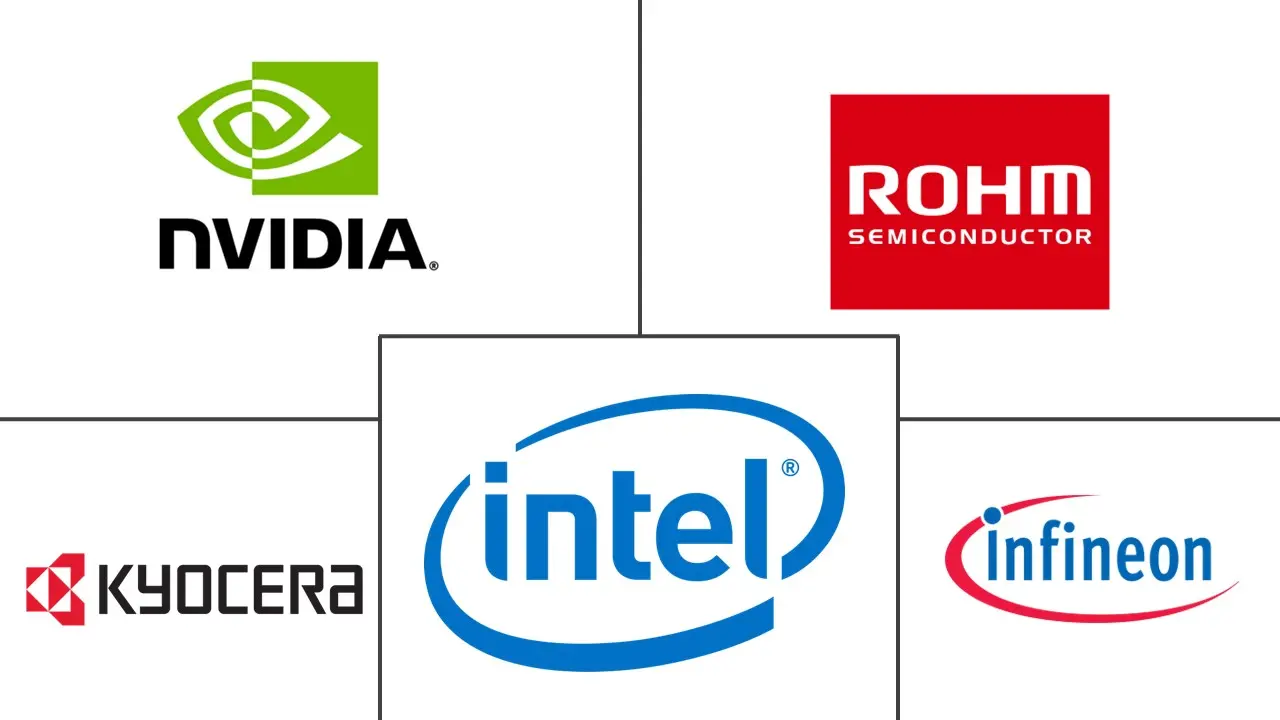Size and Share of APAC Semiconductor Device Market For Industrial Applications
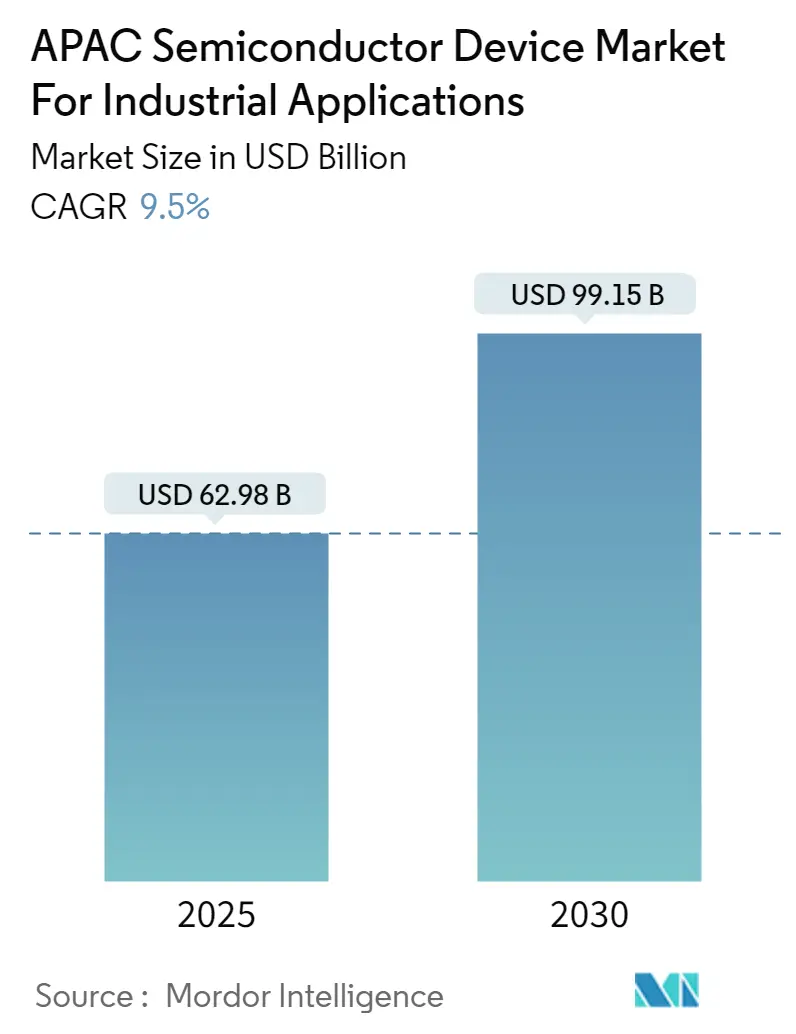
Analysis of APAC Semiconductor Device Market For Industrial Applications by Mordor Intelligence
The APAC Semiconductor Device Market For Industrial Applications Industry is expected to grow from USD 62.98 billion in 2025 to USD 99.15 billion by 2030, at a CAGR of 9.5% during the forecast period (2025-2030).
- Asia-Pacific Semiconductor Device Market For Industrial Applications is estimated to continue its robust growth during the forecast period to accommodate the increasing demand for semiconductor materials in emerging technologies, such as artificial intelligence (AI), autonomous driving, the Internet of Things, and 5G, coupled with competition among key players and consistent spending on R&D.
- Industry 4.0 is transforming the way companies manufacture their products. The term Industry 4.0 refers to the smart and connected production systems designed to sense, predict, or interact with the physical world, making real-time decisions that support production. In manufacturing, it has the potential to increase productivity, energy efficiency, and sustainability.
- One of the most important components of Industry 4.0 is the Industrial Internet of Things (IIoT), which refers to the extension and use of the IoT in industrial sectors and applications. The underlying core capabilities provided by semiconductors for IIoT include sensing, connectivity, and computing. For instance, in the context of IIoT, sensors are widely used in different industries to monitor equipment, assets, systems, and overall performance.
- For their functioning, industrial robots require sophisticated sensors that obtain important information. Sensors can use semiconductor processing units to gather external information like images, infrared light, and sound, along with internal data on temperature, moisture, movement, and position. Today, many industrial robots are equipped with 3D vision systems, which are usually comprised of multiple cameras or one or more laser displacement sensors.
- For instance, in May 2023, Agile Analog developed digitally wrapped analog IP subsystems, including power management, PVT sensing, and sleep management, to decrease the design and integration effort of SoCs. Digital design flow and IP blocks make it easier to reuse and customize designs for different applications.
Insights and Trends of APAC Semiconductor Device Market For Industrial Applications
Industry 4.0 Investments Driving The Demand For Automation
- The countries in Asia-Pacific are occupying leading positions in the transition to Industry 4.0. Significant initiatives have resulted in increased attention being given to the digital economy and Industry 4.0 in the Asia Pacific region to boost manufacturing activities, such as Singapore's Smart Nation and Committee for the Future Economy initiatives, Indonesia's '2020 Go Digital Vision', the 'Thailand 4.0' initiative, the Vietnamese government's Industry 4.0 initiatives, amongst others, which is bringing increased scope for semiconductor device market for industrial applications.
- The technologies of Industry 4.0 that will be deployed are machine-to-machine communication (M2M), supervisory control and data acquisition (SCADA), overall equipment effectiveness, customized automation system design, high-mix-low-volume manufacturing design, process traceability, and tracking system, remote monitoring, and auto reporting, production floor safety and security, and machine vision inspection system.
- Korea's commercial and public sectors have agreed to boost the number of local smart factories to have more than 30,000 working with the newest digital and analytical technology by 2022. The Ministry of Trade, Industry, and Energy (MOTIE) of Korea has reaffirmed the government's ambitions to assist small and medium-sized businesses adopt and expand smart manufacturing technology, thus driving the Asia-Pacific Semiconductor Device Market For Industrial Applications.
- Furthermore, the Japanese government announced Connected Industries in response to the German government's "Industry 4.0" program, and the momentum for a new manufacturing revolution is rising. The push toward smart factories is accelerating with technological advancements such as digitalization, production technology sophistication, and robotics to achieve higher efficiency in the manufacturing industries.
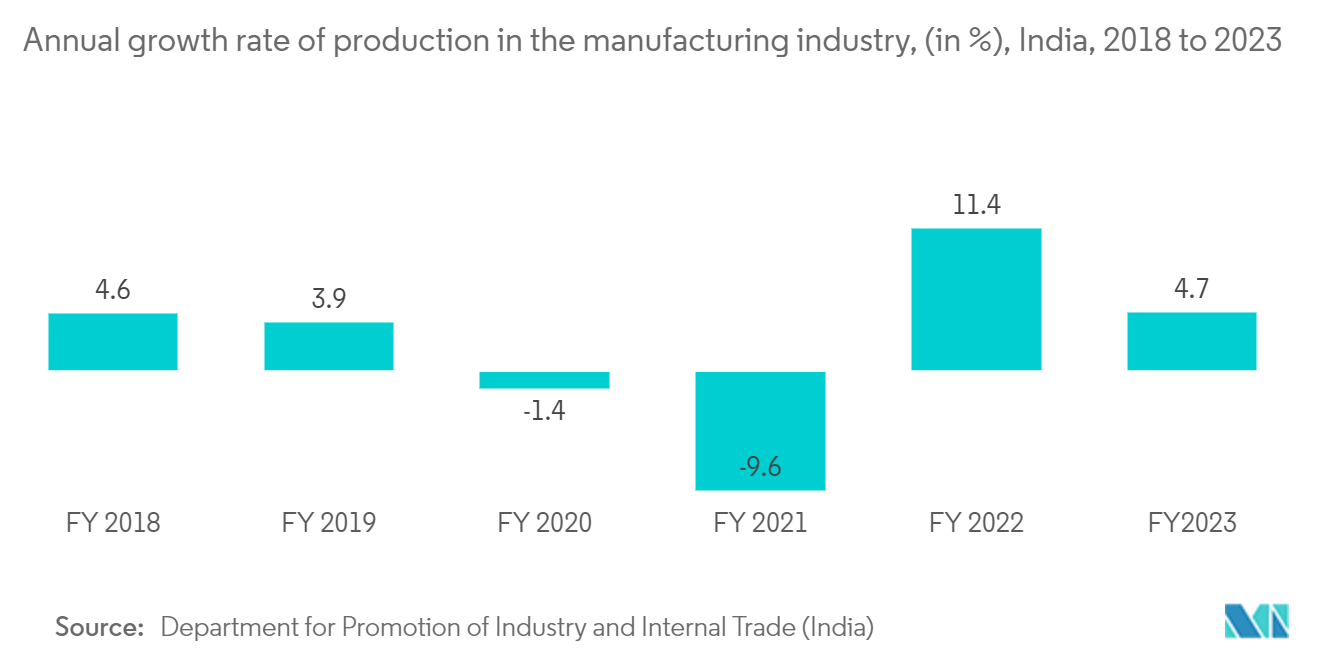
China to Hold Significant Share
According to the Mobile Economy 2021 report by GSMA, more than 990 million people in the China region presently utilize mobile internet services, with an additional 200 million predicted by 2025. Grocery purchasing is a new, emerging trend in online shopping. In China, automation is occurring rapidly, despite the wage rate being lower (compared to European nations and North America since there was an increase in wage rate over the past decade), and this is expected to continue for the next decade and to accelerate the automation, thus driving the Asia-Pacific Semiconductor Device Market For Industrial Applications.
Furthermore, the government's ambitious 'Made in China 2025' initiative, partially inspired by Germany, for Industry 4.0 aims to boost the country's competitiveness in the manufacturing sector. The ten-year plan, introduced in May 2015, is the government's bid to shift the industries to the medium-high end of the global value chain and foster several advanced manufacturing clusters. The increase in industrialization will grow the market for automated solutions such as AGVs and AMRs, which are embedded with semiconductors. Thus, cost reduction, space optimization, complex manufacturing operations, and speed of delivery will be major driving factors for the demand for the Semiconductor Device Market For Industrial Applications.
Startups, such as Syrius Robotics, based out of Shenzhen, are building autonomous mobile robots to integrate them into two model warehouses of JD Logistics for further testing and optimization for last-mile deliveries. AMH systems are expected to experience demand from the manufacturing industries, with increased throughput, warehouses, and distribution centers. Any segment directly or indirectly affected by the spike in demand in the e-commerce and retail markets is expected to escalate the need for semiconductor devices in the country.
According to survey data from the National Bureau of Statistics, China has become the world's largest industrial robot market and has had tremendous growth for the past eight years, with the trend continuing. China's industrial robot industry currently accounts for 44% of the global market, and it is expected to continue to grow.
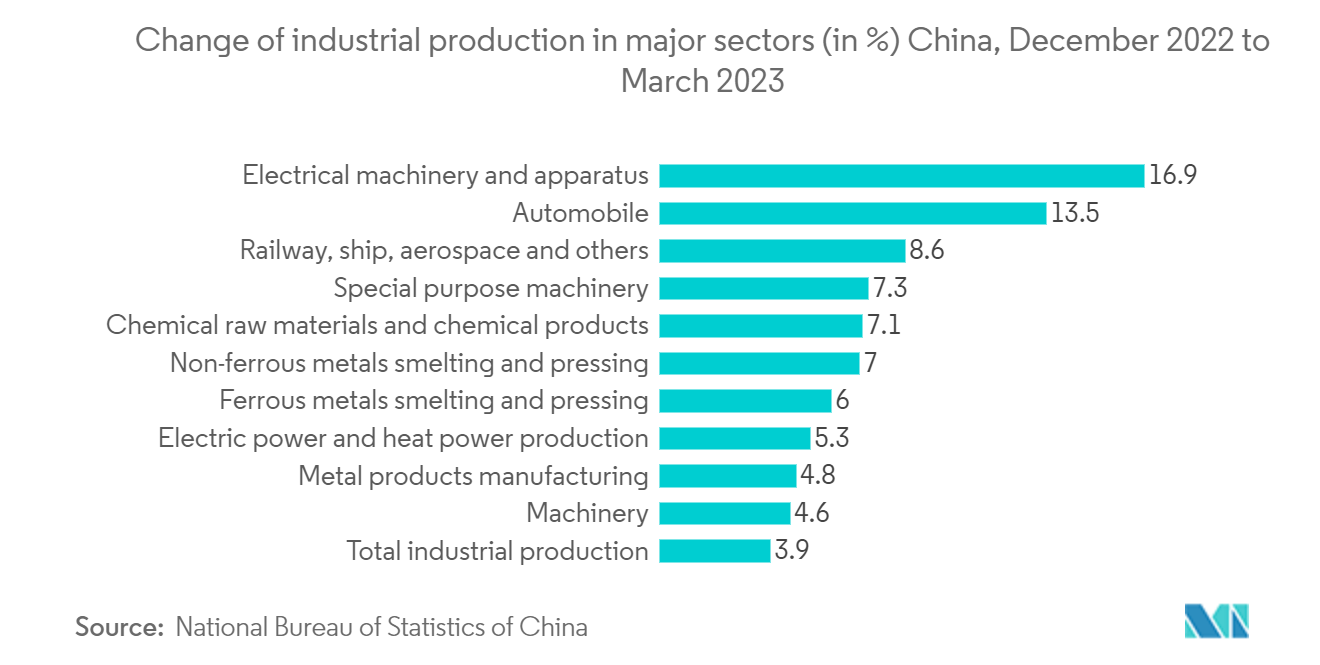
Competitive Landscape
Asia-Pacific Semiconductor Device Market For Industrial applications fluctuates with growing consolidation, technological advancement, and geopolitical scenarios. With the presence of large market incumbents, such as Intel Corporation, Nvidia Corporation, Kyocera Corporation, Qualcomm Technologies Inc., and STMicroelectronics NV, the market penetration levels are also high.
- August 2022: Renesas Electronics Corporation, a supplier of advanced semiconductor solutions, announced the development of a new generation of Si-IGBTs, which will be offered in a small footprint while providing low power losses. Aimed at next-generation electric vehicle (EVs) inverters, AE5-generation IGBTs will be mass-produced starting in the first half of 2023 on Renesas' 200- and 300-mm wafer lines at the company's factory in Naka, Japan.
- July 2022: Samsung Electronics Co., Ltd., the Global innovator in advanced memory technology, announced that it has successfully developed the second generation of its pioneering SmartSSD. The SmartSSD is playing an increasingly important role, especially with the growth of next-generation technologies such as AI, machine learning, and 5G/6G, which require large amounts of data processing.
Leaders of APAC Semiconductor Device Market For Industrial Applications
-
Nvidia Corporation
-
Intel Corporation
-
Kyocera Corporation
-
Qualcomm Incorporated
-
STMicroelectronics NV
- *Disclaimer: Major Players sorted in no particular order
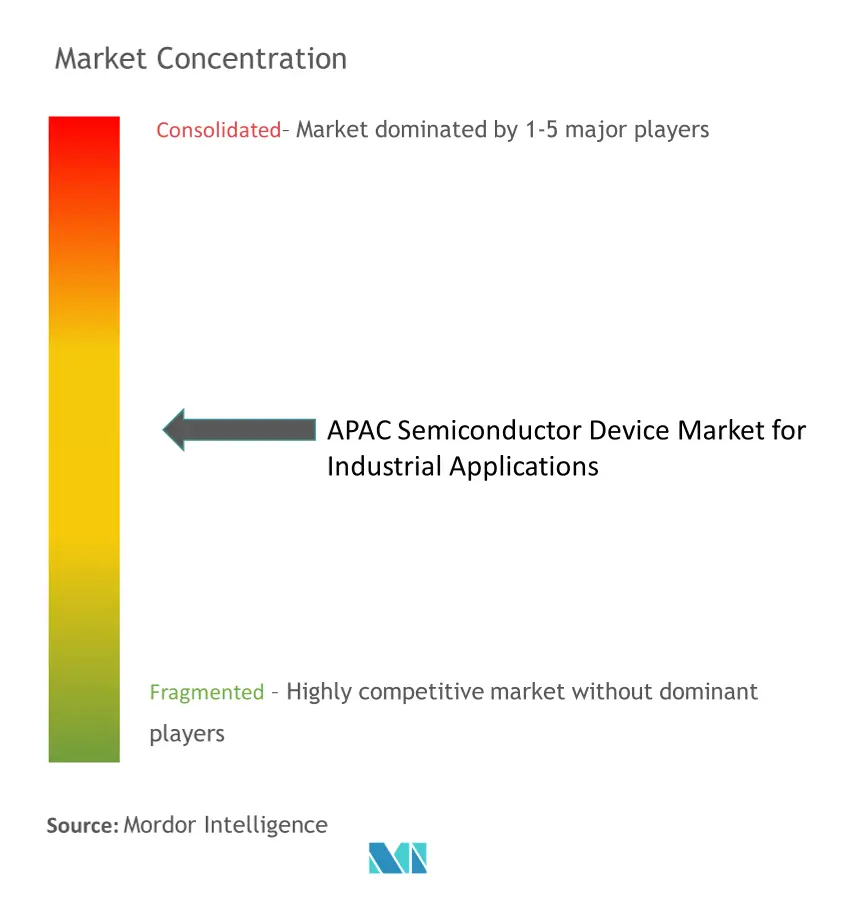
Recent Industry Developments
- May 2024: SK Hynix has unveiled ZUFS 4.0, a cutting-edge solution designed specifically for on-device AI applications in mobile devices, notably smartphones. Positioned as a flagship offering, the company anticipates that ZUFS 4.0 will not only solidify its leadership in AI memory within the NAND segment but also further leverage its success in high-speed DRAM, as seen with HBM.
- March 2024: Toshiba has introduced eight new products to its M4K Group within the TXZ+ Family of Advanced Class 32-bit microcontrollers. These microcontrollers are powered by the Cortex-M4 core with FPU. The latest additions come in four different package types and boast an enhanced flash memory capacity of 512KB/1MB, a significant upgrade from Toshiba's previous maximum of 256KB. Additionally, the RAM capacity has been boosted from 24KB to 64KB across the range.
Scope of Report on APAC Semiconductor Device Market For Industrial Applications
The study analyzes the market of semiconductor devices for industries in terms of the revenue accrued. For the scope of the study, the report includes devices such as Discrete Semiconductors, Sensors, and Integrated Circuits for the market sizing calculation, and all the other devices, such as passive components, are excluded from the study. The study also covers the activities of major players in the market along with their current strategies, recent developments, and product offerings.
Asia-Pacific semiconductor device market for industrial applications is segmented by device type (discrete semiconductors, optoelectronics, sensors, integrated circuits (analog, logic, memory, micro (microprocessors, microcontrollers, digital signal processors)) and by country (China, India, Japan, and Rest of Asia Pacific). The market sizes and forecasts are provided in terms of value (USD) for all the above segments.
| Discrete Semiconductors | ||
| Optoelectronics | ||
| Sensors | ||
| Integrated Circuits | Analog | |
| Logic | ||
| Memory | ||
| Micro | Microprocessors (MPU) | |
| Microcontrollers (MCU) | ||
| Digital Signal Processors | ||
| By Device Type | Discrete Semiconductors | ||
| Optoelectronics | |||
| Sensors | |||
| Integrated Circuits | Analog | ||
| Logic | |||
| Memory | |||
| Micro | Microprocessors (MPU) | ||
| Microcontrollers (MCU) | |||
| Digital Signal Processors | |||
Key Questions Answered in the Report
How big is the APAC Semiconductor Device Market For Industrial Applications Industry?
The APAC Semiconductor Device Market For Industrial Applications Industry size is expected to reach USD 62.98 billion in 2025 and grow at a CAGR of 9.5% to reach USD 99.15 billion by 2030.
What is the current APAC Semiconductor Device Market For Industrial Applications Industry size?
In 2025, the APAC Semiconductor Device Market For Industrial Applications Industry size is expected to reach USD 62.98 billion.
Who are the key players in APAC Semiconductor Device Market For Industrial Applications Industry?
Nvidia Corporation, Intel Corporation, Kyocera Corporation, Qualcomm Incorporated and STMicroelectronics NV are the major companies operating in the APAC Semiconductor Device Market For Industrial Applications Industry.
What years does this APAC Semiconductor Device Market For Industrial Applications Industry cover, and what was the market size in 2024?
In 2024, the APAC Semiconductor Device Market For Industrial Applications Industry size was estimated at USD 57.00 billion. The report covers the APAC Semiconductor Device Market For Industrial Applications Industry historical market size for years: 2019, 2020, 2021, 2022, 2023 and 2024. The report also forecasts the APAC Semiconductor Device Market For Industrial Applications Industry size for years: 2025, 2026, 2027, 2028, 2029 and 2030.
Page last updated on:
Report on APAC Semiconductor Device Market For Industrial Applications
Statistics for the 2025 APAC Semiconductor Device For Industrial Applications market share, size and revenue growth rate, created by Mordor Intelligence™ Industry Reports. APAC Semiconductor Device For Industrial Applications analysis includes a market forecast outlook for 2025 to 2030 and historical overview. Get a sample of this industry analysis as a free report PDF download.
